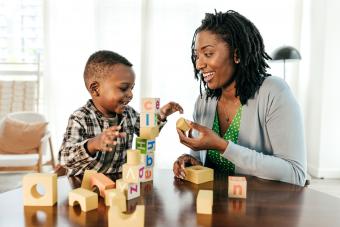
Most parents have heard of a Montessori education, but this way of learning isn't just designed for the classroom! Parents can easily implement the Montessori method at home and give their kids even more opportunities to learn and grow.
If you're wanting to discover how to bring this highly respected teaching technique into your living space, we break down how to do Montessori at home, from easy ways to change your space to simple tips on implementing the practice.
Understanding the Montessori Method
The Montessori method is a child-led way of learning that encourages order, independence, and responsibility. Children participate in thoughtfully prepared activities that teach them practical life, language, sensorial (colors, textures, shapes, etc.), mathematical, and cultural skills.
The main principles of Montessori circle around hands-on learning, freedom (with reasonable limits), observation, the belief that play is how children learn, and a prepared environment.
When a child's environment is uncluttered and accessible, they have the freedom to engage in hands-on activities that allow them to grasp essential life skills. This allows them to develop in their own unique way.
Montessori at Home: How to Transform Your Space

In order to apply Montessori at home, an essential step is preparing your space. The keys to creating the ultimate Montessori experience in your home are simplicity and self-sufficiency.
This means cutting out the clutter, selecting Montessori-style toys and practical items for play, and keeping your play space organized. Here are three easy ways to make this happen so that you can make the most out of Montessori activities.
Simplify Your Space

Did you know that too many toys can actually hinder creativity and focus? The best way to foster discovery and learning is to give your child a limited selection of high-quality and purposeful toys. Many Montessori activities feature multi-functional objects that allow children to get the most out of the pursuit.
To do this, purge unnecessary items that will not foster the learning of practical skills and organizing what remains so that your child can easily access these items for play.
Montessori organization utilizes open shelving that only measures 1-2 feet in height. Each shelf then has a designated type of toy that is clearly displayed in the space. Remember that less is more. Additionally, if one of the activities includes building blocks, you want to utilize a wide and shallow, open topped bin or basket so your child can clearly see the items and easily transport them to their play space.
Choose the Right Toys

We mentioned purging low value items, but what qualifies as such? Glad you asked! Montessori toys require your child to use their hands, their minds, and their imaginations. Examples include:
- Sorting and stacking toys
- Building blocks
- Magnetic tiles
- Puzzles
- Play Doh
- Busy boards
- Musical instruments
- Climbing toys
- Art supplies
- Play kitchens
- Wooden food slicing sets
Montessori toys are also free of bright lights and noises. In other words, if your parents or your parent's parents didn't have that type of toy in their childhood, it likely isn't aligned with the Montessori approach.
Give Your Child Access to Basic Items
Another intent of the Montessori approach is to teach self sufficiency. This means being able to wash their own hands, get their own water, and the ability to help with certain daily tasks. Here are some simple ways that parents can make their homes more accessible to their kids.
Kitchen:

Parents can either invest in little play kitchens to store their children's plastic water cups, plates, and towels (for cleaning up their own messes) or they can clear out a low shelf in the kitchen and stock up their child's supplies there.
For sink or counter access, parents can purchase a basic step stool (to be used while under supervision) or they can invest in a toddler step stool that comes with safety rails. These materials are important for allowing your child to engage in different types of practical play, like helping with meal prep, washing dishes, or setting the table.
If you have the space, you may also want to consider adding a child-sized table and chairs. This can also make it easier for them to participate in certain household chores and it gives them an additional play surface for art activities.
Bedroom:

Just like there can be too many toys, there can also be too many clothes. That is not to say that you have to purge your child's closet, but rather, you should group entire outfits together on hangers to make decision making easier.
Then, display these ensembles on a closet rack that your child can reach. This gives them the responsibility of getting ready for the day and the freedom to select what they want to wear.
Play Areas:

As mentioned above, proper shelving and organization is key to making play areas accessible to kids. Another key component of Montessori play areas is the use of small rugs, blankets, and mats.
These "work mats" create a structured area for completing activities. This can help your child better focus on the activity at hand. They also come in handy when you have multiple kids playing in the same space. Children are more likely to respect each other's work when it is in a designated area for that child.
Yoga mats can be a great choice because they not only provide a sturdy play surface, but your kids can also easily roll them up and put them away when play times are over. This allows parents to clearly recognize when a child wants to engage in play as well as when they are all done.
How to Do Montessori at Home

Once you have your space prepared, it becomes quite easy to implement the Montessori method at home! Simply give your toddler a tour of all the spaces that they now have access to and let them explore.
Then, start modeling and practicing different practical skills and engaging in open play. Examples of these activities include:
Model Daily Chores
Parents can start by showing kids how to conduct certain daily chores. These can include setting the table, taking out the trash, or feeding your pets. Remember, play is work and work is play in the world of Montessori. It is how kids learn and grow.
Invite Them to Help
Inviting them to help in the kitchen is a great place to start. An easy way to implement Montessori at home is to set up a weekly menu with regular items that your child gets to help prepare. Once they understand how to complete these tasks, make that a part of their daily responsibilities. Some ideas include:
- Pizza: Forget takeout! Buy pre-made crust and ingredients and have your kids assemble their own pizzas each week.
- Pasta Salad: This is another safe and easy meal that toddlers can help prepare. Have them cut ingredients with a toddler safe knife, measure out the correct portions, and mix the different food items together.
- No-Bake Energy Bites: Your toddler can get their hands messy making these protein packed treats. This makes for a great sensory activity to enjoy!
- Fruit Salad: This is another easy option. Toddlers can wash and cut the fruit and then mix it together.
- Frozen Treats: Popsicles and yogurt bark are also simple recipes that your kids can craft all by themselves. They won't mind eating them either!
Let Kids Engage at Their Own Pace
Parents can start by pulling out play mats and selecting activities to play. Parents should first play the activities by themselves with their toddler in the room. If your toddler wants to engage, let them! If they simply want to watch, then continue to do the activity by yourself.
Show Kids How to Put Items Away
Parents can also model Montessori at home by putting items away once play is done. A picture is worth a thousand words! Don't just tell your child to put their toys and mats away, show them where they go. After a few play sessions, they will begin to mimic your actions and memorize where things belong.
The Montessori Method at Home & in School Brings Independence
Montessori is not just a way of living and learning. It's a tool for raising capable and confident human beings. Research shows that just two years of Montessori education is associated with a significantly higher adult wellbeing as well as improved engagement abilities, social trust, and self-confidence. It's a simple way to build a foundation for your child's future - and you can start by making small changes at home.







